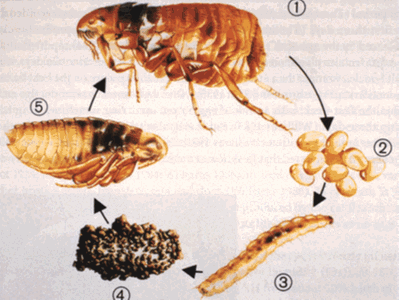
My pets are having a problem with fleas. Nothing I do seems to work. What options do I have?
Fleas are the most common parasite I see in dogs and cats. Due to the mild weather in Southeast Texas, they are a year-long problem. Pets can acquire fleas any time they visit an area that is infested. Such places may include areas frequented by other dogs or even areas with wildlife, such as raccoons and opossums.
The most common flea of both dogs and cats is the cat flea. To understand how best to rid your pet of fleas, it is important to be aware of the flea life cycle. There are four stages to the life cycle. The first stage is the egg, which represents about 50% of the total flea population in your environment. A single adult flea can lay 40 to 50 eggs every day and up to 2000 fleas in her lifetime. The eggs fall off your pet into the carpet, bedding, furniture, cracks in the floor, etc. Anywhere your pet spends time may be infested with eggs.
In as few as 14 to 28 days, the eggs may hatch into flea larvae. These larvae account for 35% of the flea population. Larvae dislike light, so they migrate into warm, dark, moist areas such as deep into carpet fibers, under furniture, or under leaves, decks, or branches.
The flea larvae then develop into a cocoon-like form called a pupa, which makes up approximately 10% of the fleas in your home. Their cocoon is like a thick, protective coat which makes the pupae resistant to insecticides. A pupa will not hatch until stimulated by vibrations, heat or carbon dioxide emitted from your pet.
Under appropriate conditions, a pupa can emerge into an adult flea in 5-10 days; but it can also survive for up to 9 months. So if you have ever experienced a ?sudden? flea problem after returning home after a vacation or moving into a new home, it is very probable all these pupae were already present, just waiting for the right signals from you and your pet.
Once the adult flea emerges from the cocoon, it heads for the light and waits for a passing dog or cat to feed upon. It is a common misconception that fleas jump from pet to pet. Once on an animal, the flea will remain on the pet for the remainder of the flea?s life. The adult fleas that you see account for only 5% of the total flea population.
If conditions are right, the entire life cycle from egg to adult flea can be completed in as little as 14-28 days. So in just 30 days, 10 fleas can become an infestation of up to 250,000 adult fleas!!!
Successful flea control includes treating your ALL your pets year-round. Even one untreated pet will serve as a constant food source and allow new fleas to develop.
The type of flea product used is also important. The powders, sprays, shampoos, dips and flea collars available at your local store are not generally effective. They may kill some of the adult fleas on your pet, but are gone in a few hours and do nothing to treat the other 95% of the flea problem. And many of the over-the-counter dog preventatives, if mistakenly applied to a cat, are toxic or even deadly. Excellent, veterinary-recommended flea preventatives that are administered to your pet once every month are available.
There is no single ideal product for every dog or cat; so your veterinarian can help you decide what will work best for your situation. Just remember that the keys to successful flea control include understanding the flea life cycle, being consistent with prevention every month all year-round, and treating every household pet ? indoors and out.
